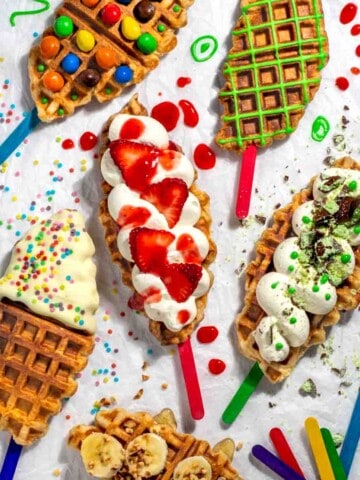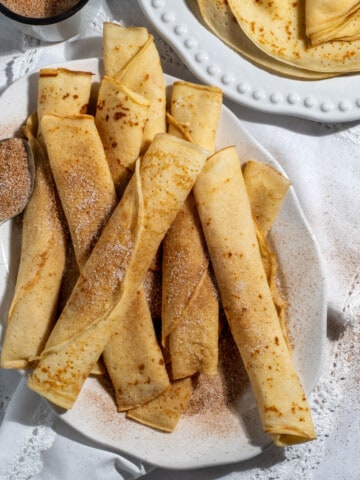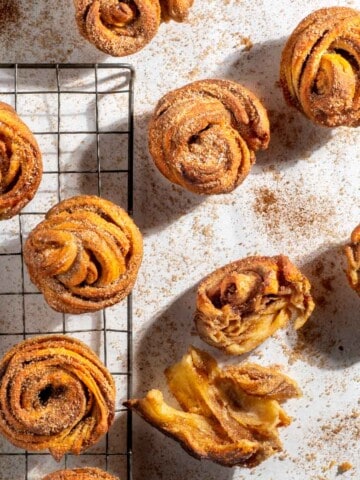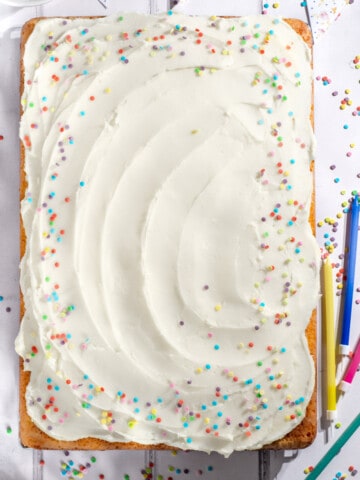Vanilla, oh vanilla, thou sweet delight. In every dish, thou mak'st our hearts take flight!
Is what Shakespeare would have said!
Yes, we confess - we are absolutely obsessed with vanilla! Just the mere sight of those tiny specks dancing in a sea of cream or nestled within a scoop of velvety ice cream makes our hearts race and our souls sigh in pure delight.
Vanilla is special. It's warm, sweet, comforting, familiar and truly unique among all the spices in the world. Almost everyone's a fan and you can use it in countless ways in the kitchen.
We go through a lot of vanilla in our house and let's face it, it can be quite a pricey habit, especially if you're chasing the high-quality stuff.
However, a few years back, we decided to take matters into our own hands and began making our own vanilla extract. It was a complete game-changer, surpassing anything you can find on store shelves and also much easier on the wallet.
We're here to persuade you to give homemade vanilla extract a shot.
It's the easiest thing to do. Just two simple ingredients and a pinch of patience are all it takes. The end result is absolutely worth your time and initial investment.
So, if you're a fan of vanilla and prefer top-notch quality but flinch at the price tag, this homemade vanilla extract recipe is tailor-made for you.

Jump to:
- Why should you make your own vanilla extract?
- Key ingredient notes and substitutions
- The vanilla pods
- How many vanilla pods to use
- Is it really cheaper? We did the sums
- Best bottles to use
- Should you slice the vanilla pods?
- How to make your own homemade vanilla extract
- Organising your vanilla
- Ageing vanilla extract
- Topping up and storing
- Waste not, want not - Start a Mother Jar!
- Some recipes using vanilla extract
- Recipe
Why should you make your own vanilla extract?
- Homemade vanilla extract is of higher quality compared to many commercial options or imitation vanilla.
- It's more budget-friendly to make your own vanilla extract, saving you money in the long run, especially if you use it frequently. We did the calculations.
- Homemade vanilla extract is free from artificial flavours, colours or preservatives, ensuring a pure and natural product.
- Making your own extract is a rewarding and satisfying DIY project that yields a high-quality ingredient for your cakes and bakes.
- Makes a great gift for a fellow foodie.
- You can choose ethically sourced vanilla beans and reduce packaging waste.
- Exceptionally long shelf life.
- You can experiment with different types of vanilla beans or alcohol.

Key ingredient notes and substitutions

The vanilla pods
Choose your flavour:
Vanilla beans come in a plethora of varieties, cultivated in various countries along the "vanilla belt." Madagascar, Mexico, Papua New Guinea, Indonesia and Uganda are among the prominent origins but there are numerous others.
Do they have distinct flavours? Absolutely! Much like coffee and chocolate, whole beans acquire their unique taste from the specific soil and climate of their growth region.
Here's a brief overview of the vanilla varieties listed:
Madagascar vanilla beans: Known for their rich and creamy flavour, often described as the classic and most widely used type of vanilla.
Mexican vanilla beans: They have a slightly spicy and woody flavour with a hint of smokiness, making them distinct and well-suited for various recipes.
Papua New Guinean vanilla beans: The Tahitian vanilla beans grown in PNG are renowned for their floral and fruity notes, often characterised by a cherry-like scent and taste.
Indonesian vanilla beans: Resembles Madagascar vanilla with sweet, creamy notes but it offers a more complex flavour profile with earthy and woody undertones, along with subtle fruity hints akin to figs.
Ugandan vanilla beans: Ugandan vanilla has a sweet, creamy flavour with hints of dried fruit and subtle notes of milk chocolate.
Choose your grade:
Now, you've got to pick between grade-A and grade-B vanilla beans. Grade-B beans are drier and less costly. They're perfect for making homemade vanilla bean powder and extracts.
Grade-A beans have more moisture, making them great for various uses, including extracts, but they might be a bit pricier.
What we use:
Our top choice for vanilla pods in the UK is from Vanilla Mart (they are not paying us to say nice things, we just love them!), offering premium Madagascar beans at excellent prices. Their quality has consistently impressed us with every bean we've received.
In essence, the world of vanilla offers a diverse range of flavours. Choose your favourite. Don't hesitate to opt for grade-B beans, or spring for grade-A if your budget allows. The choice is yours!

Vodka
Vodka is a great choice as a spirit because it doesn't have a strong taste or smell. It stays in the background, allowing the vanilla flavour to stand out.
Its see-through quality also allows you to watch the vanilla's colour change over time.
Most store-bought vodka has a high enough alcohol content for making pure vanilla extract, which requires at least 70 proof alcohol.
For the best homemade vanilla extract, aim for alcohol content between 35% (70 proof) and 45% (90 proof). This range guarantees the sweetest and purest vanilla flavour.
You don't have to spend on an expensive vodka brand. A low to mid-priced one works well. Rather invest your pennies in high-quality whole vanilla beans, as they are crucial for that sweet, classic extract flavour.
You can also try different alcohols like Bourbon, brandy, whisky or rum, but remember they will impart a whole different flavour profile to your vanilla extract. If this is your first time making extract, we'd recommend sticking to vodka for now.
Can you make vanilla extract without alcohol?
Yes, you can use food-grade vegetable glycerin instead, but keep in mind that it lacks the preservative qualities of alcohol so your extract won't last as long.
Mix three parts glycerin with one part water.
Also, bear in mind that it takes more time to develop its flavour and won't be as dark and rich as when using alcohol.
How many vanilla pods to use
When it comes to making 'pure vanilla extract' for commercial purposes, there are specific measurements and standards to follow. According to the USA's FDA regulations, it's 13.35 ounces of extract-grade vanilla to one gallon of alcohol, to be exact. That's enough complication to make your head spin!
While we aim for a similar ballpark figure, we won't lose any sleep over it because we're making this for personal use, not for sale.
You also have the choice of making single-fold vanilla extract and double-fold vanilla extract, with the latter containing twice the number of pods and being highly concentrated. We're sticking with single-fold, similar to store-bought extracts.
One piece of advice - instead of counting them, weigh the pods. They come in various sizes, widths and moisture contents. Keep in mind that two plump grade-A pods might weigh the same as four drier grade-B pods. However, we'll still provide a rough estimate of how many pods you might need.
We've found a formula that works well for us:
15 grams of vanilla pods for every 200ml of vodka.
To put it in perspective, 15g of pods is approximately equivalent to five plump grade-A vanilla pods
Is it really cheaper? We did the sums
Disclaimer - Please note that our calculations are based on the costs of vanilla pods and vodka in the UK in October 2023. The prices and availability may vary depending on your location, the quality of the pods and the brand of vodka you choose.
To make one bottle of 200ml homemade vanilla extract
| Supplies | Cost per 200ml |
| Smirnoff vodka from Sainsbury's @£1.80/100ml (Oct '23) | £3.60 |
| Premium Madagascan Bourbon Vanilla Pods (10 pack) from Vanilla Mart @£1.50/pod (Oct '23) | £7.50 |
| Total cost per 200ml | £11.10 |
Shopbought pure Vanilla extract per 200ml
| Supplies | Cost per 200ml |
| 60ml Nielsen-Massey Vanilla Extract from Sainsburys @£9.58/100ml (Oct '23) | £19.18 |
Conclusion
| Cost per 200ml | |
| Homemade vanilla extract | £11.10 |
| Shopbought vanilla extract | £19.18 |
Homemade vanilla extract using mid-range products is initially 42% cheaper than the store-bought vanilla extract.
But it doesn't stop there.
You can continue to top up your vanilla extract with vodka as you use it. With every batch, you can extract at least double the volume before the vanilla pods start to lose their potency.
Considering that you'll ultimately yield 400ml of extract, you'll need to add an extra £3.60 for the 200ml 'top-up' vodka.
So, with a total expenditure of £14.70 for 400ml of homemade extract, if you keep topping up your vodka over time, your homemade version becomes 61% cheaper than the store-bought alternative.
Not bad!
Best bottles to use

Always use glass bottles, never plastic.
The nature of plastic makes it more porous compared to glass. This permeability means that oxygen (O2) and carbon dioxide (CO2) are more likely to pass through a plastic container than a glass one. That's precisely why high-quality spirits are consistently bottled in glass rather than plastic and this should be the case for homemade extracts too.
We personally opt for transparent glass because we enjoy watching the different phases of the extract as it matures. However, you can certainly use darker glass containers, like amber bottles, if you prefer.
Just ensure your bottle seals tightly and that they are squeaky clean before using.
We also choose bottles with a plastic stopper because it helps control the pouring speed. This feature is especially useful when dealing with larger bottles, making it easier to pour out small quantities like a teaspoon.
If you're making vanilla extract for personal use, you can upcycle any suitable glass bottle. But if it's a gift, consider using attractive, small bottles or mason jars and add a nice homemade label or tag.
Should you slice the vanilla pods?
We do. Slicing or cutting the vanilla pods before adding them to the bottle helps expose more of the flavorful seeds inside the pods to the alcohol. This allows the extraction process to happen more quickly and thoroughly.
We also like the seeds to form part of the extract, creating that classic vanilla appearance with the characteristic black specks.
Leaving the pods whole is an option, but be prepared for a longer maturation time for the extract. If the pods are too long for your bottle, you can bend them in half or tie a knot in them.
How to make your own homemade vanilla extract

- First, ensure your glass container is clean and dry.
- Weigh out the required amount of vanilla pods you will need.

- Split each vanilla pod in half lengthwise with a pair of kitchen scissors. If they're too long for the bottle, you can also cut them in half crosswise.

- You can also use a sharp paring knife for this process.

- You don't have to slice the pods all the way through, it's fine to leave one end intact for easier handling.

- Push the pods into the bottle.

- Ensure the pods are deep enough inside the bottle to be fully covered with the vodka once you add it. If they look too long, remove them and cut them shorter or fold them in half.

- Use a funnel or a jug to fill the bottle with vodka until the pods are completely covered.

- It's a good idea to leave some space at the top of the bottle to allow for shaking.

- Seal the bottle tightly and shake it well.
- Store the extract in a cool, dark place like a kitchen cupboard, away from direct sunlight. Give it a good shake once a week and let it mature for at least 4 months, ideally a year.
Organising your vanilla

- When making multiple bottles or starting a rotation, it's a smart move to label each bottle with the date.
Ageing vanilla extract

Here's the unvarnished truth: Homemade vanilla extract truly hits its stride after a full year of slow extraction.
But the silver lining is that you don't have to wait that long. You can start using it after around 120 days, but the choice is yours. We've been there and it tasted terrific, but believe us, it's on another level after a year.
Once you establish a routine and regularly make new bottles each year, it becomes a non-issue.
To kick things off, prepare a large batch consisting of several bottles, depending on your usage. If your anticipation gets the better of you, it's perfectly fine to crack open the first bottle after 120 days, provided you have more waiting in the wings when you hit that one-year mark.
In the meantime, maintain the cycle by creating extra bottles to tuck away and let the passage of time work its magic.
Topping up and storing
Topping up your extract with vodka is a great option, and we highly recommend it. We often get a double batch from each bottle we've made thanks to regular, small top-ups.
In fact, it's a good practice to ensure the vanilla pods are always submerged in the alcohol. This helps prevent them from becoming a bit slimy over time.
You can continue topping it up until you notice the pods starting to lose their strength.
Alternatively, you can introduce fresh pods to the bottle.
The alcohol acts as a preservative, allowing vanilla extract with pods to remain usable for several years. For extracts where the pods have been removed after full extraction, they can essentially last indefinitely. Yes, you read that right - indefinitely!
Waste not, want not - Start a Mother Jar!
The phrase does bring a smile to our faces, but it's the real deal!
A Mother Jar is essentially a generously sized jar, usually 1-5 litres, where you can give a new purpose to all your spent, leftover or extra vanilla pods.
Just toss them in, whether they're the off-cuts, extras, 'deaded pods' or any other pods you have and always keep them submerged in alcohol.
Surprisingly, some of the finest extracts are born in Mother Jars, making it a brilliant way to squeeze every last drop of value from those precious vanilla pods. With the price of vanilla these days, it makes complete sense.
It's like the grand finale of your vanilla pod's journey.
How do you know if it's ready to use when you keep adding all sorts of pods to it? Well, you don't really. You just need to rely on taste. If it tastes good to you after a few months, use it.
Alternatively, put your spent vanilla pods in a bowl of granulated sugar for a lovely, subtle vanilla sugar.
Recipe

Homemade Vanilla Extract
Equipment
- 1 200ml glass bottle - Or 250ml to allow some room for shaking.
- 1 pair of scissors or a sharp knife
- 1 funnel
Ingredients
- 15g whole vanilla pods - Or approximately 5x plump vanilla pods (½ ounce)
- 200 millilitre vodka
Instructions
- First, ensure your bottles are clean and dry.
- Weigh out the required amount of vanilla pods you will need.15g whole vanilla pods
- Split each vanilla pod in half lengthwise with a pair of kitchen scissors or a sharp-tipped knife. If they're too long for the bottle, you can cut them in half crosswise too.You don't have to slice the pods all the way through, it's fine to leave one end intact for easier handling.
- Push the pods into the bottle.Ensure the pods are deep enough inside the bottle to be fully covered with the vodka once you add it. If they look too long, remove them and cut them shorter or fold them in half.
- Use a funnel or a jug to fill the bottle with vodka until the pods are completely covered. It's a good idea to leave some space at the top of the bottle to allow for shaking.200 millilitre vodka
- Seal the bottle tightly and shake it well.
- Store the extract in a cool, dark place like a kitchen cupboard. Give it a good shake once a week and let it mature for at least 4 months, ideally a year.
- When making multiple bottles or starting a rotation, it's a smart move to label each bottle with the date.
**Nutritional data disclaimer**
Please keep in mind that the nutritional information provided below is calculated by a third party and we cannot guarantee the accuracy. We try our best to give you the most accurate information, but we do not take responsibility for errors that may be present. Also, the nutritional value of the recipe may change depending on the exact brands and products used. We recommend that you consult with a qualified healthcare professional or registered dietitian for personalised advice on your dietary needs.
Nutrition
For food safety advice, including guidance on food allergies






Leave a Reply